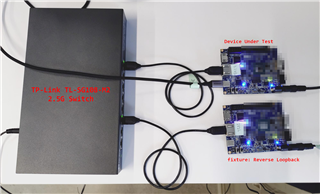Tool/software:
Hi TEAM,
customer found the DP83867 packet loss issue and did some test.
The connector of RJ45 they used is 8207S-81000075-1 including the transformers
1. test FPGA MAC and DP83867CR MII lookpack and digital loopback, no packet loss. It seems not RGMII issue for packet loss
2. connect using 2pcs DP83867CR board, and set reverse loopback mode for 1 board, no packet loss issue occurred.
3. Bridge 2pcs DP83867 boards with TP-Link TL-SG108 (1G Switch), it works fine
4. Bridge 2pcs DP83867 boards with ZYXEL XGS1250-12 (Multi-Gig Switch) or TP-Link TL-SG108-M2 (2.5G Switch), there was around 0.5% packet loss
check related registers for the above connection test, the loop quality is around 40~90
It seems that packet loss occurs when connected to specific Multi-Gigabit switches (ZYXEL XGS1250-12, TP-Link TL-SG108-M2), but is normal when tested with a standard 1G switch (TP-Link TL-SG108) or PHY Direct Loopback/Reverse Loopback, does the DP83867CR have specific register configurations, known compatibility issues, or recommended debugging directions?
Please help!
Thanks.



